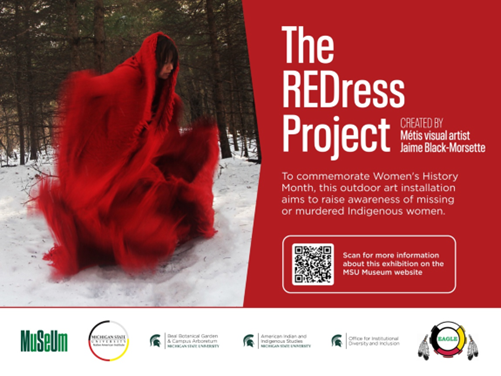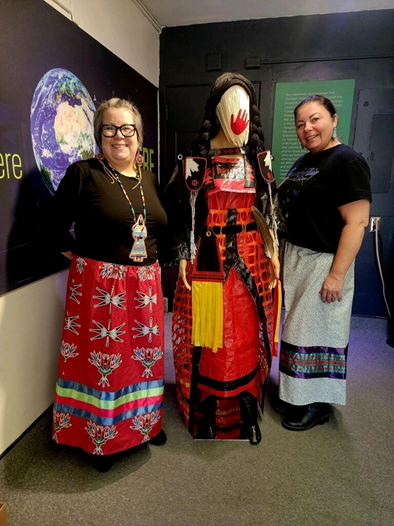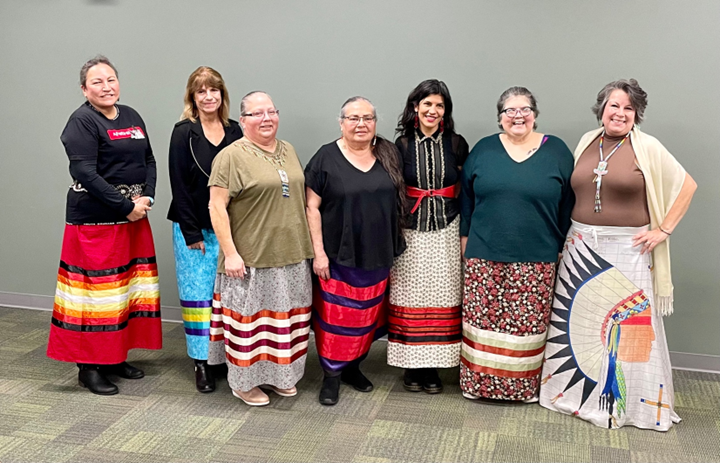
This story contains references to lives lost and sensitive topics regarding violence perpetrated against women.
Women’s History Month is a time dedicated to recognizing women’s contributions and efforts throughout history. In 2024, this observance began on March 1, when people on MSU’s campus may have noticed 60 red dresses installed along West Circle Drive in areas around the MSU Museum and Beal Botanical Gardens. These dresses were part of an art installation titled The REDress Project by Métis artist Jaime Black-Morsette.
Black-Morsette created the project in 2009 in response to the ongoing crisis of missing and murdered Indigenous women and girls in North America.
Indigenous women in Canada and the United States face disproportionately high rates of violence, which is why Black-Morsette became inspired to create this art piece. The project raises awareness of the issue and serves as a visual reminder of the growing number of those experiencing violence.

Jaime Black-Morsette
“Through the haunting beauty of suspended red dresses, The REDress Project affirms our commitment to amplifying Indigenous voices, advocating for their rights and standing in solidarity against the epidemic of violence on Indigenous women and girls, demanding justice and accountability,” said Native American Institute (NAI) Director Kevin Leonard, who played a role in connecting with Black-Morsette.
The project has traveled to over 50 locations globally, visiting museums and universities. To bring the exhibition to MSU, the MSU Museum collaborated with the NAI, the American Indian and Indigenous Studies (AIIS) program, Beal Botanical Garden, EAGLE (Educating Anishinaabe: Giving, Learning and Empowering), and Project 70/60 from the Office for Institutional Diversity and Inclusion.
The red dresses for the exhibition at MSU come from Black-Morsette’s collection, which has been gathered over time and from donations from local Native communities.
“MSU is sadly no stranger to issues of violence or sexual assault. And as we work to heal and do better as a community, having this installation here reminds us all of the resiliency in loss and the ways we all might work to raise visibility and make change,” said Kristin Arola, director of the AIIS and a Gillmor Endowed Professor in Professional and Public Writing.
Raising visibility and making change are precisely what Black-Morsette had in mind when creating the project. The dresses are left empty, without mannequins, intentionally. They symbolize the absence and presence of Indigenous women and girls affected by violence while creating a platform to further the conversation.

Becky Roy (left) and Rachel Rodgers
Becky Roy, Lansing resident and Wiikwemkoong First Nation Tribal member, helped create an art installation alongside the REDress exhibition to draw attention to the issue. As Roy worked on it, the project transformed and gathered interest from her friends in the Native community, including Rachel Rodgers, Wiikwemkoong First Nation Tribal member, who assisted with the setup.
In addition, the following women community members contributed to the piece: Gloria Gizhiiwegdiziikwe Mainville Manitowabi, Ojibwa of Couchiching First Nation; Dr. Nichole Keway Biber, WaabanAnang, LTBB Waganakising Odawa, Mishiike Dodem; Roxanne DeLand-Phillips, LTBB Waganakising Odawa, Little Traverse Bay Band of Odawa Indians; Kathy Yates, Nokomis Board Member; Michelle DeLand, LTBB Waganakising Odawa; Carol Howard, Waabananangoons, LTBB Waganakising Odawa.
The Bureau of Justice reports that when Indigenous women are victims of violent crimes, 88% of the perpetrators are non-Indigenous. In the U.S., federally recognized Tribes lack jurisdiction to prosecute non-Indigenous people for crimes committed on Tribal land.
“Highlighting issues important to American Indian and Indigenous communities is an important act for MSU,” Arola said. “If we are to truly hold MSU accountable to the needs of American Indian and Indigenous peoples, as the AIIS land acknowledgment states, part of that work is leveraging our resources to raise awareness about issues important to our communities.”
To do this, the Office for Institutional Diversity and Inclusion (IDI), with help from Arola and MSU Dialogues Coordinator Jade Richards, sponsored a screening of the documentary Bring Her Home on March 12. The film follows three Indigenous women as they work to honor and bring about justice for their relatives who have been victims of the ongoing crisis.

“Both the art installation and the documentary bring awareness to the issue of MMIW [Missing and Murdered Indigenous Women] and shine a light on the loss and grief communities feel,” said Brady Velazquez, equity and compliance coordinator for IDI. “Jaime Black-Morsette said in an interview that she picked the color red because someone told her that red is the only color spirits can see, so both the art installation and the documentary act as a way to show and honor those lost — to symbolize that they aren’t forgotten and that people are fighting for their justice.”
“The MSU Museum is honored to present this installation in collaboration with our campus partners,” said MSU Museum Director Devon Akmon. “This project embodies our vision of an MSU community, inspired and informed by the arts, working collaboratively, creatively and equitably to solve problems and pursue a better world for all.”
By: Stephanie Palagyi and Brigita Felkers

